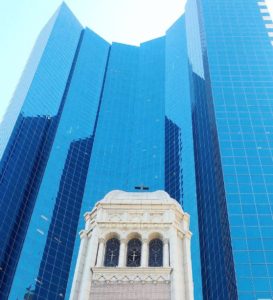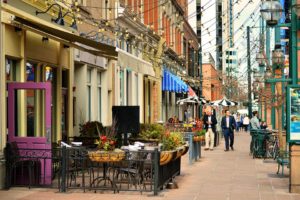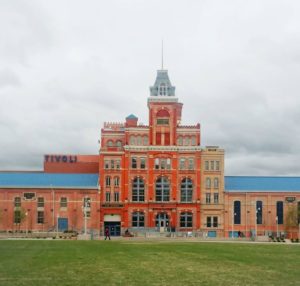By Eva Miranda | Rocky Mountain Chapter Secretary
The city that is now Denver resulted from people rushing to the state for gold. Before Denver, there was Auraria, and before Auraria, there were grazing cattle. As a result of a fast-growing settlement, matching buildings were not planned, and architectural styles were not consistent across the city, let alone across the street.
According to History Colorado, you can find almost three dozen architectural styles across the state. Denver has striking examples of Art Deco, Classic Revival, Collegiate Gothic, Googie, Gothic and Greek Revival, Renaissance Revival, and Rustic.
This wide variety of building styles represents the variety of the people of Denver over the last 200 years. While I was going to school and working downtown, it was such a joy to walk around and seemingly travel through time. I want to share some of my favorite buildings and some of their history, and encourage you to walk around while you are here! You can find a route to these buildings here, and a route to the related buildings here.
Colorado State Capitol Building

The pride of Denver is found in the golden-domed (yes, real gold) state capitol building on Colfax, facing Civic Center park. This Classic Revival style building, completed in 1894, is a showcase of the wonderful resources in Colorado. (Spoiler alert: I like geology.) The gleaming white exterior is constructed of Yule Marble, also used in the construction of the Washington Monument. Inside you’ll find unique Rose Marble and Rose Onyx with such distinct texture that some of the formations have been named! Working your way upstairs, you’ll see scenes of Colorado life depicted in the stained glass. While the dome gleams with Colorado gold, beneath are panels made of copper, also mined from Colorado. Scattered throughout the building you’ll find paintings, sculptures, plaques, quilts, and other pieces of art. Touches of the past can be found in the original (converted) light fixtures. Tours are free or self-guided, and highly recommended.
Related buildings
- Nearby is Civic Center park, which features grassy areas, a roman amphitheater, and fountains.
- Also nearby and of the same style is the State Museum Building.
- The other building in Denver made of Yule Marble is the Byron White U.S. Courthouse.
Trinity United Methodist Church
Constructed in 1887 by Robert Roeschlaub, the Trinity United Methodist Church, a small stone church surrounded by glassy skyscrapers, sits on the corner of 18th and Broadway. The chapel is made of Castle Rock Rhyolite, a volcanic stone in hues of purple, gray, and blue. A closer look at the volcanic stone reveals tiny crystals scattered throughout, making it a special treat to catch the chapel in the sunlight. The outside of this building showcases beautiful gothic steeples and beautiful stained glass. Inside you can take a self-guided tour Monday through Friday, or make a reservation for a guided tour.
Brown Palace Hotel

The country’s second fireproof building was completed in 1892 in Denver. Striking red Colorado granite and Arizona sandstone draws your eye as you approach the Brown Palace hotel along 17th street and invites you to discover more beauty in detail. The red color is more than skin-deep, with walls made from terra-cotta instead of wood (thus being fireproof). Walking around the outside looking up to the seventh floor, you’ll discover decorative carvings of Colorado wildlife, my favorite being the buffalo on 17th street. The striking shape of the building makes you forget the lack of detail on the outside of the building. The rounded corners of this triangle building tuck it away from Broadway. Walking inside, you enter a gateway to a luxurious interior. An eight-story atrium stretches above the grand piano, encouraging you to stop on your way from the Ship’s Tavern and the Churchill Bar. The second floor features the Grand Salon, which matches the lobby in Mexican Onyx. Tours of the hotel take guests through the eight-story ballroom as well as more of the history of the hotel. Unseen to guests (even on the tour) and mostly unknown is an underground tunnel connecting the Brown Palace and the former annex across the street. Used by employees to get to and from work, the tunnel has proven to be more than just urban legend.
I’d encourage you to check out these other local historic (and beautiful) hotels:
Holy Ghost Church

Walking by this building to admire the beautiful blending of modern and Renaissance, I never knew the Holy Ghost church was also home to a 300-ton installation of Colorado Marble. Considering how much I love marble I was shocked that I had no idea of the gems (or travertine) inside . The church, with a 110-foot tower, seems lovingly cradled by the blue glass skyscraper behind. The exterior is ornate, featuring truly Renaissance-style detail in the arches, doorways, and windows. The cornerstone was placed when construction began in 1924 The church was not completed until 1943.
Another beautiful local church is the Cathedral Basilica of the Immaculate Conception.
Buerger Brothers Building & Annex
You can find a surprising and rare example of Art Deco at the Buerger Brothers Building & Annex on Champa Street. Built in 1930 and 1895, respectively, the buildings were clad with art deco panels in 1937, with the Clay building being transformed from red-brick Victorian. While the buildings are now used for luxury lofts and office space, the façade is the true beauty, featuring blues, reds, and browns not found elsewhere in the city.
Another rare example of Art Deco in Denver is the nearby Magnolia Hotel.
Daniels and Fisher Tower

Walking up 16th Street at Lawrence, you'll be struck by the beautiful light brick of the Daniels & Fisher Tower against the blue sky behind it. Reminiscent of the St. Mark’s Campanile in Venice, this tower is a piece of Venice on the streets on Denver. While it is no longer the tallest building west of the Mississippi River (as it was at construction in 1910) it is still striking. Decorated with clock faces on all four sides and hosting a bell inside, the tower also boasts ornate decorations inside and out.
While it was once built for a department store, the clock tower now offers tours and private events. You can even get engaged there! Or enjoy a drink at the Clocktower Cabaret on the first level.
Market Street
The historic buildings on Market Street, now home to bars, restaurants, and retail, were once more infamous in Denver. Known as “The Row,” brothels, dancehalls, and parlor houses were so widespread that the family the street was named after petitioned to change the name! However, because the scandalous business was centrally located, residents north and south petitioned to change the name of their section of the street. They were successful, and you can now go from Market Street to Walnut, back to Market. Walking north now you’ll see the former Wells Fargo headquarters, matching five story brick buildings a block abreast, and what was formerly Jennie Roger’s Hall of Mirrors. At the top hall of mirrors, you’ll spot a bust of Jennie herself peering down from the eaves.
Another beautiful area to take a walk and explore history is the Ninth Street Park, located on the Auraria campus.
Union Station
Originally built in 1881, the original Union Station met the same fate as many buildings in gold mining towns when it burned down in 1894. The reconstruction, completed in 1914, upheld the original mission of serving the Union Pacific Railroad; the Denver & Rio Grand Western; Denver, South Park & Pacific; and the Colorado Central Railroads. The building was, and still is, a transportation hub in Denver for people and goods. Architecturally, the building is styled in both Romanesque and Revival style. Around the station, specifically outside the Terminal Bar, you'll find columbines detailing the space. In a space that was filled with somber ticketing booths and benches filled with drab travelers, the Great Hall is now full of movement and bright people. Surrounded by shops filled with books, chocolates, and gifts, you're invited to enjoy ice cream or a cocktail while you enjoy the architecture. Travelers and locals alike pass through an ever-full space during the weekends. Take a closer, guided look inside any day on a guided tour. The $20 tour, provided by the Crawford Hotel, includes a beverage from the terminal bar. Proceeds from the tours benefit The Crawford's Dollars For Dreams nonprofit partners.
Ellie Caulkins Opera House

Another historic building that is now a hub is the Ellie Caulkins Opera House. Now the heart of the Denver Center of Performing Arts, the “Ellie” is a beautiful center of activity. Below a six story atrium, you’ll find statues and theatres connected by pavers.
While Robert Willison was the city architect at the time of construction, I struggle to describe the style of this building. Maybe it is a uniquely Denver look, or I lack the vocabulary. Either way, this building is the perfect container for all of the activity and art found inside. The cornerstone was laid in 1908, and since then the building has hosted everything from operas to rodeos. The exterior of the opera house is ornate and beautiful. The cornices wrap around the building’s edge, capping the light brick that make up the walls. Above every window and door you’ll find beautiful detail, as well as between every window. In my opinion, the corner of 14th and Champa provides the best view to take in the detail. For a view of the inside, register for a tour.
Larimer Square

The woman involved in reviving Union Station, Dana Crawford, is more famous for her revival of the first historic district in Denver, Larimer Square. Established in 1858 by William E. Larimer, this commercial area was used by prospectors during the flourishing gold rush (and located less than a mile away from the first gold found in Colorado). Only five years later, a fire prompted a change of scenery from wooden to brick buildings. This transition brought us many unique buildings such as the Kettle building, for which only front and rear walls were built between other buildings, and the Granite building, whose significant location features a door on the corner. Looking up while strolling down Larimer street, you’ll find beautiful cornices, historic lentil stones, and construction dates of the buildings.
Now Larimer square is a beautiful block where you can spend a relaxing day taking in the sights. Unique-to-Colorado businesses line Larimer Street between 14th and 15th. I recommend starting a day with muffins at the Market, then browsing shops, and finishing with champagne at Corridor 44. Take a tour of the historic street (and the Clock tower) 2, 4, 9, or 11 May with Historic Denver.
Tivoli Brewery

While the Tivoli pays tribute to its roots as a brewery, the use of the building has grown. Originally a five-story brick complex in 1900, the building showcases a unique façade decorated with cornices and window detailing that emphasize the locally-sourced red brick. Inside during the week, the Tivoli complex is teeming with college students of the shared campus. The atrium and food court area highlight the height of the building, and a trip up the tower elevator (across from the brewery entrance) rewards you with a beautiful view west. While there are no tours, the building is open to the public and easily explored. Walking around, you’ll encounter plaques and original brewing equipment that tell a story of Buck Beer and maybe a ghost story or two.
Some other beautiful brick buildings in LoDo are:
Sources
- https://en.wikipedia.org/wiki/Denver_Union_Station
- https://www.larimersquare.com/50/history.html
- https://coloradoencyclopedia.org/article/daniels-and-fisher-tower
- https://www.historycolorado.org/location/buerger-brothers-building-annex
- https://www.flickr.com/photos/wallyg/6165083902
- https://www.historycolorado.org/location/trinity-united-methodist-church
- https://www.colorado.gov/pacific/capitol/history-capitol
- https://leg.colorado.gov/content/tour-information
- https://www.historycolorado.org/tivoli-brewery
- https://www.historycolorado.org/story/going-places/2018/11/26/brief-walk-along-denvers-notorious-market-street
- http://denverhistorytours.blogspot.com/2009/10/history-of-naming-of-market-street.html
- https://www.brownpalace.com/our-hotel/history/

